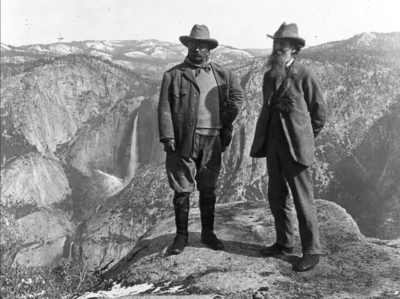"Conservation movement"
(Ideology, Population control) | |
|---|---|
 | |
| Interest of | • Fred Matser • Jonathan Oppenheimer • Laurence Rockefeller |
| Many billionaires are highly passionate about emptying the land. | |
See also environmentalism The conservation movement, also known as nature conservation, is a political, environmental, and social movement that seeks to manage and protect natural resources, including animals, plants and marine species, as well as their habitat, for the future.[1]
While most people supports protection of wildlife and sensitive nature areas, it is noticeable that many billionaires are highly passionate about the subject. The deep politics aspect includes plans for very extensive conservation areas - entire regions cleansed of people - and the methods they are willing to use to achieve that goal.
Contents
History
The early conservation movement evolved out of necessity to maintain natural resources such as fisheries, wildlife management, water, soil, as well as conservation and sustainable forestry. The contemporary conservation movement has broadened from the early movement's emphasis on use of sustainable yield of natural resources and preservation of wilderness areas to include preservation of biodiversity. Some say the conservation movement is part of the broader and more far-reaching environmental movement, while others argue that they differ both in ideology and practice.[2]
Rewilding
Rewilding activities are conservation efforts aimed at expanding wilderness areas. The US/Swiss billionaire Hansjörg Wyss, through his Wyss Foundation, aims to help conserve 30 per cent of the Earth in a natural state by 2030 and believes this is 'achievable' because he’s seen what can be accomplished.[3]
The organization Nature Needs Half lobbies for 50% of the earth to be conservation zones by 2030.[4]
30×30 treaty
In December 2022, at the United Nations biodiversity conference in Montreal (COP15), nearly 200 countries signed a last-minute deal to vastly increase the amount of territory within which human activity is restricted or prohibited. The agreement, under the guise of biodiversity[5], sets out a target of ensuring 30 percent of "areas of degraded terrestrial, inland water, and coastal and marine ecosystem" are under "effective restoration" by the end of the decade, with a goal to "enhance biodiversity and ecosystem functions."[6] This is up from around 15 percent of all land and 7 percent of oceans in 2022.[6] Campaign posters around the conference center promoting 30×30 were sponsored by the Wyss Foundation.[7][8]
Survival International, an international non-government organisation that works for human rights, said that the 30 by 30 goal will create militarised no-go areas and displace around 300 million indigenous people from their native lands and forests in the name of "conservation." They will be "restricted from accessing the resources, hunting and practicing agriculture. Such restrictions are not applicable to tourists and people with money. Sometimes extractive industries are also allowed in these areas once the local people are evicted."[9]
The US government is not part of the treaty, but the Biden administration set its own 30 percent goal by 2030[10][11].
Debt-for-nature swap
Debt-for-nature swaps are financial transactions in which a portion of a developing nation's foreign debt is forgiven in exchange for local investments in environmental conservation measures.[12] These transactions are part of the Davos agenda.[13]
Natural Asset Companies
In October 2023, the US Securities and Exchange Commission allowed the creation of Natural Asset Companies (NACs).[14][15] The following are natural commons are eligible for NACs: National Parks, National Wildlife Refuges, Wilderness Areas, Areas of Critical Environmental Concern, Conservation Areas on Private and Federal Lands, Endangered Species Critical Habitat, and the Conservation Reserve Program. Such companies will hold the ecosystem rights to the land, water, air, and natural processes of the properties enrolled in NACs. Each NAC will hold "management authority" over the land, allowing charging for carbon sequestration, biodiversity and clean water sources. If the population are issued carbon allowances, owners of said lands will be able to claim tax deductions and will be able to sell carbon allowances to businesses, families and townships.[16][17]
Examples
| Page name | Description |
|---|---|
| Club of Rome | Environmentalism with more than a hint of misanthropy |
| Pennie Hedge | |
| National park | The remote locations of national parks, protected by special laws and armed forces, make them ideal for covert activities. |
| Panthera | Conservationist NGO accused of being a secret regime change operator against Iran. |
| Theodore Roosevelt | US president 1901-1909 |
| Sierra Club | Front group for the WWF, 1001 Club, Club of Rome and similar misanthropic Population reductionists |
| The 1001 Club | A nature trust started by a billionaire businessman and a co-founder of the Bilderberg Group, which raises funds for the Worldwide Fund for Nature (WWF). |
| World Wildlife Fund | An international charity connected to the secretive 1001 Club, which formally is part of the WWF. |
Related Document
| Title | Type | Publication date | Author(s) | Description |
|---|---|---|---|---|
| Document:Some Big Lies of Science | article | 8 June 2010 | Denis Rancourt |
References
- ↑ http://www.mackinac.org/9852
- ↑ https://en.wikipedia.org/wiki/Conservation_movement
- ↑ https://www.nytimes.com/2018/10/31/opinion/earth-biodiversity-conservation-billion-dollars.html?action=click&module=Opinion&pgtype=Homepage
- ↑ https://natureneedshalf.org/
- ↑ https://nodealfornature.wixsite.com/info
- ↑ Jump up to: a b https://news.yahoo.com/five-things-know-global-biodiversity-224014491.html?fr=sycsrp_catchall
- ↑ https://www.motherjones.com/politics/2022/12/cop15-2022-un-biodiversity-convention-united-states/
- ↑ https://insideclimatenews.org/news/14012020/biodiversity-treaty-climate-change-marine-sanctuary-conservation-protected-areas-wildlife-habitat-forests/
- ↑ https://www.downtoearth.org.in/interviews/forests/cop15-montreal-30x30-will-create-more-militarised-protected-areas--86534
- ↑ https://thehill.com/policy/energy-environment/552043-biden-officials-endorse-meeting-conservation-goals-through/
- ↑ https://americanstewards.us/issues/30x30/
- ↑ https://en.wikipedia.org/wiki/Debt-for-nature_swap
- ↑ http://archive.today/2023.12.16-051302/https://www.weforum.org/agenda/2023/06/climate-finance-debt-nature-swap/
- ↑ https://www.nyse.com/introducing-natural-asset-companies
- ↑ https://www.intrinsicexchange.com/nacs
- ↑ https://impactentrepreneur.com/natural-asset-companies-nacs/
- ↑ https://elizabethnickson.substack.com/p/deplorables-killed-net-zero-and-esg